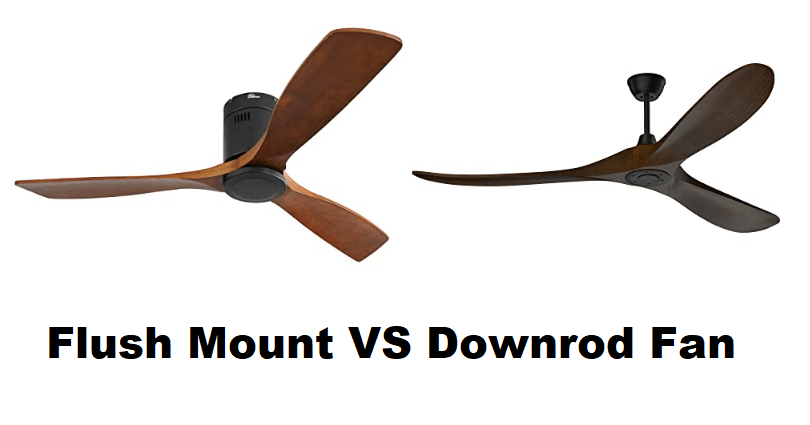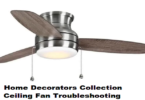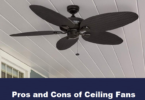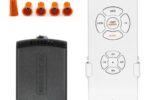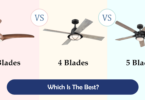Flush mount ceiling fans are designed to hug the ceiling, while downrod ceiling fans hang farther away. Therefore, downrod fans are easier to install and maintain, have great efficiency and run more quietly than flush mount fans.
Contents
Difference Between Flush Mount and Downrod Ceiling Fan: Overview
Both a flush mount and a downrod ceiling fan are controllable with different controllers, both have blades to provide airflow, and both can be installed in any setting.
The most unique feature between these fans is that the flush mount fan is established so that the base of the fan hugs the ceiling. On the other hand, a downrod ceiling fan can be taken away from the ceiling with the help of a downrod that is available in different sizes.
What Is a Flush Mount Ceiling Fan
A flush mount ceiling fan is a type of fan that is directly connected to the ceiling by its base, making it ideal for smaller spaces or rooms where a drop mount fan may appear too large.
These types of fans are available in numerous sizes, styles and designs, but they are often used in confined spaces and not be suitable for larger rooms.
Flush mount ceiling fans also have the option to install lights or no lighting.
The controller type includes wall switch, remote, pull cords, or a mixture of all these controls.
Purchase Price
Flush mount ceiling fans are not pricier than downrod ceiling fans.
The reason behind it is that a flush mount ceiling fan requires less equipment, and they are smaller in size to adapt the areas in which they are mounted.
This is only applicable to flush mount and downrod models. Many fans have the two mounting options which is why offer the same price tag.
Installation and Maintenance are Easy
It is a skillful task to install a flush mount ceiling fan, the cause behind it is that it is near to the ceiling when you work with it.
You have to keep your hands between the fan and the ceiling in order to connect the wires. All the tasks will have to perform with your hands over your head or with your head pressed against the ceiling and your neck will remain at a different angle.
Alternatively, if the wires are already short, it will be a hard nut to crack to lay new wires or try to extend the old ones.
It is more difficult to do the maintenance.
If you have to fix the screw in the junction box, you will need a shorter screwdriver in order to work between the fan body and the ceiling.
It will be hard to clean the blades because they are closer to the ceiling.
Another thing to keep in mind is not to press too hard on the blades to avoid the wobbling of the fan.
Flush mount ceiling fans come with motors that run harder (you will be able to know in the next section of the article). This will result in hard maintenance and it will ask for maintenance more frequently.
Effectiveness and Efficiency
Effectiveness means that how well a ceiling fan moves to generate air and efficiency means how much electricity a ceiling fan is consuming to generate the amount of air.
Flush mount ceiling fans come with less efficient and less effective in terms of installation.
The fan blades and ceiling are left with the less space, which causes the low airflow from the ceiling.
In this direction, the air remains between the ceiling and the blades, causing turbulence and causing loss of energy.
To generate a specific amount of airflow, the fan will run in a special direction, the fan will have to run for a long time and spend too much effort to take over the energy loss. It results in less efficiency.
Flush mount ceiling fans used to generate 4,000 CFM per minute of air. The is the lower side but the it is still good. A ceiling fan that produces 5,000 cubic feet per minute can be categorized as average.
It does make sense because no one wants to make a ceiling fan that was not good enough? They are not enough efficient or effective, but that categorizes them as inefficient or ineffective.
Noise Level
The noise level of flush mount ceiling fans is louder as compared to downrod ceiling fans.
There are three main reasons behind it.
First of all, most of the noises in a ceiling fan produces by the motor while working. If the motor is using more power to operate as it will require more effort when it is being used in a flush mount ceiling fan, it will be louder than normal.
Secondly, motors that are using more power to function on a regular basis are more likely to strain and develop mechanical issues. These can result in even more noise.
In early childhood, I used to use a flush mount ceiling fan that was always noisier as if it would burst into flames and the motor was working harder which is why it was hot to touch.
Thirdly, the turbulent air above the fan will result in louder operation.
Related Read: Pros and Cons of Flush Mount Ceiling Fans
What Is a Downrod Ceiling Fan
Downrod ceiling fans use a rod (a metal tube) to keep the blades and motor at arm’s length from the ceiling.
In general, downrods fans are installed on higher ceilings that can be managed while maintaining the ceiling fan clearances.
Downrod ceiling fans are available in different designs, sizes and styles so you can customize them.
These units can also be equipped with pull cords, wall switch control and remote controls. They can also come with all of these controls. They may or may not contain lights.
Purchase Price
Downrod ceiling fans are pricier than flush mount ceiling fans. the reason behind it is that a downrod fan needs more equipment and they are also larger in size.
However, the price difference is minor if you compare the fans that are different in terms of installation.
Ease of Installation and Maintenance
It can be difficult to install a downrod ceiling fan if the wires in the fixture have been cut too short.
It will be difficult to feed the wires through the rod, especially if there is a dent.
However, most part of the installation of downrod fans is easy because the installation gives you extra room to work and you do not have to perform it by staying close to the ceiling.
Usually, the maintenance of downrod fans is easier because the fan is lower than usual.
Downrod ceiling fan’s motor is not operated as hard which can be a positive addition to the maintenance.
You can install downrod ceiling fans on sloped ceilings if the rod can be long enough to support it to avoid the blades from hitting the lower side of the ceiling.
Effectiveness and Efficiency
Downrod ceiling fans are ahead of flush-mount ceiling fans in terms of effectiveness and efficiency.
The airflow of downrod ceiling fans is not restricted if it is installed away from the ceiling. In fact, this enables them to work in an effective way to generate air.
This also makes the downrod ceiling fan more efficient. The motor does not have to work hard as the airflow is not restricted by the ceiling.
On average, downrod ceiling fans generate high Cubic feet per minute, something between 6000 to 10000 CFM. This is only possible due to the many characteristics we have discussed above.
Noise Level
Flush mount ceiling fans are noisier than downrod ceiling fans.
The main reason behind is the motor of the downrod fan as it does not have to perform harder. It also prevents the motor from wear and tear which can result in additional noise.
Differences Between Flush Mount and Downrod Ceiling Fans (Table View)
| Flush Mount Ceiling Fan | Downrod Ceiling Fan | |
| Distance from ceiling | Hugs ceiling (closer) | Hang down from the ceiling with options on the distance |
| Cost | Can be less pricey | Can be costly |
| Installation | More difficult | Easier |
| Maintenance | Maintenance is harder | Maintenance is easy |
| Effectiveness | Lower | Higher |
| Efficiency | Lower | Higher |
| Noise levels | Louder | Noiseless |
Should I Get a Flush Mount or Downrod Ceiling Fan?
If you want to get a fan for a taller ceiling or even for a standard ceiling, our recommendation is a downrod fan. If you are looking for a fan for low ceilings, a flush mount ceiling fan will be better.
If the height consideration is not an issue, a downrod ceiling fan is our recommendation. In short, it is the best option to install as a ceiling fan. You can also get a downrod fan with dual mounting options that enables you to update the mounting in order to adjust it even after installing it.

